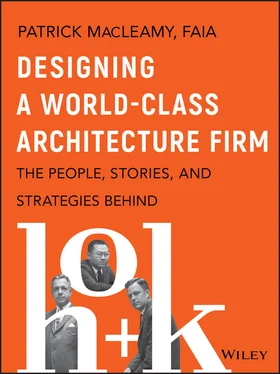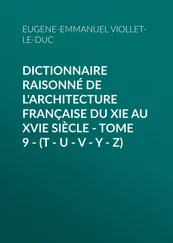By 11 a.m. Monday morning, HOK employees were back to work. One design team, working on a new Duke University Hospital project, was preparing a presentation they were to make the very next day. Team member Larry Sauer, told the newspaper, “We never considered telling the client not to fly here for the presentation.” 1 Another presentation, for Community Federal Bank, was due that Friday, but the fire had incinerated the model the team planned to show the client. It had taken two weeks to build the elaborate model. The team constructed a new one, complete with miniature landscaping, in four days.
No one ever questioned whether this was part of the job or whether the company would pay them overtime. Staff arrived on their own and did what was needed. HOK was open for business the following Monday morning, and client meetings already on the calendar proceeded without a hitch. “No management people called anyone. No one was asked. They just came,” Obata told the St. Louis Post-Dispatch . 2
The fire was an unexpected challenge—piled on top of all the expected ones—but the response by HOK people was a testament to the strength of HOK Culture.
Chapter 4: To Design a World-Class Firm
1 Encourage collaboration inside as the best way to compete outside.
2 Respect your employees, and they will return the favor.
3 Set egos aside to seek out the very best ideas and solutions, no matter who they come from.
4 Develop your own form of considerate communication.
5 Praise good work publicly; deal with problems privately.
6 Take good care of your employees and they will take good care of your clients.
7 Tell and retell the stories of your own firm to share your values and pull people together.
1 1Patricia Rose, “A Phoenix Rose at HOK,” St. Louis Post-Dispatch, November 27, 1974. Accessed April 21, 2019. https://www.newspapers.com/image/140699320.
2 2Ibid.
CHAPTER 5 Growth: Project Offices
The three founders were united around the goal of geographic expansion beyond their St. Louis roots in accordance with Hellmuth's depression-proof-firm strategy. After all, if they were going to design a world-class architecture firm, they needed to get out into the world. But each founder had a different idea about where , and how , to expand.
Hellmuth told his partners, “You simply have to establish a real presence in New York and Washington. Too much significant work is going on there to be among the missing.” 1 He was in a hurry and proposed buying a firm with an established reputation in each city. The advantage of his approach was instant local credibility, but the disadvantage was the high initial purchase price.
Obata had a special interest in San Francisco; He wanted to plant the HOK flag where he had been “kicked out” many years earlier. Kassabaum favored Los Angeles, which was emerging as the dominant West Coast city. Both Obata and Kassabaum liked the idea of winning major new commissions in other cities, establishing project offices there, and then marketing for new work as the project was underway. The advantage of their approach was low initial cost, but the disadvantage was establishing local credibility, which could take years.
So, they agreed to disagree—and did both. It was expedient for HOK and is not a bad idea for any firm to grow opportunistically, depending on which opportunity presents itself in different markets. Sometimes HOK expanded by growing from a project office and sometimes by buying another firm, depending on the opportunity. In the early years, most new offices grew out of project offices.
Planting a Flag in San Francisco
In 1966, HOK won the commission to design a new graduate library for Stanford University. Obata led design from St. Louis, and HOK assembled a small team in San Francisco to coordinate and complete the project. “Stanford University said they'd give us their Graduate Library project if we opened an office in the Bay Area, so we opened a small office,” Obata recalled later. “I was familiar with it since I was born there.” 2
Temporary project offices like this one supported specific projects, and often included staff from local firms that partnered with HOK to do the work. Hellmuth was convinced HOK could get more Bay Area work if a good marketer could look for new clients while the Stanford project was underway. He remembered Dan Gale, who had impressed Hellmuth as a natural marketer when he worked for HOK in St. Louis. After several years, Dan had left HOK and relocated to the clear air of Aspen, Colorado to alleviate his daughter's asthma. Hellmuth called Dan and persuaded him to relocate to California as the new HOK San Francisco marketing principal. Dan accepted, one of many to return to HOK—once—and began a search for work. But the work he found was not in San Francisco. It was in Alaska. HOK's project locations were about to get way more exotic.
One of the ways architects find projects is by networking with contractors, engineers, and other consultants. In San Francisco, Dan met Richard Flambert of Flambert & Flambert, a kitchen consultant that specialized in designing large, institutional kitchens for hotels, universities, and hospitals. Flambert traveled extensively in his practice, including to Alaska, which was booming after the discovery of North Slope oil and the construction of the Trans-Alaska pipeline.
Flambert had consulted for Crittenden, Cassetta, Wirum & Cannon (CCWC), an architecture firm in Anchorage, and knew they were swamped with design jobs and struggling to handle larger and more challenging projects. In 1969, he offered to introduce Dan to CCWC senior partner Ed Crittenden, and the two traveled to Anchorage for a meeting. It was a perfect fit. CCWC had more contracts than it could handle and HOK San Francisco needed work. HOK immediately began to provide design and production leadership for the largest and most challenging Alaska projects while assisting CCWC with smaller work. The two firms began marketing to Alaska clients together as CCWC & HOK, winning more commissions around the state, including a high school on Kodiak Island, student housing for the University of Alaska Fairbanks campus, and a major addition to Providence Hospital in Anchorage.
By late 1969, Alaska work was so substantial that Obata asked Bill Valentine, his most trusted designer, to move to San Francisco as the first design principal outside of St Louis, effectively turning the little project office into the first permanent satellite HOK office. Bill recalls that when he agreed to move to San Francisco, Obata said, “That's good … could you fly to Anchorage in the morning?” Things were moving that fast. Sometimes you just have to seize the moment, even if it's a stretch.
HOK opened the San Francisco office just 11 years after its founding. Over the next seven years, HOK created three more offices—in Washington, DC, Dallas, and New York. The founders discovered opening new offices was difficult and would learn many sobering new lessons.
Launching in Washington, DC
As the San Francisco office grew, Hellmuth established a marketing office in Washington, DC to support his regular trips there to market to federal agencies. Setting up a marketing-only office is another way of growing and makes sense in a target-rich environment like Washington, where Hellmuth called regularly upon the General Services Administration (GSA), the State Department, the Army Corps of Engineers, and the Smithsonian. His early efforts led to a State Department commission to design the U.S. Embassy in San Salvador.
Hellmuth visited Smithsonian officials often, and in 1965 secured the commission for a major new museum on the National Mall, the park connecting the Capitol building and the Lincoln Memorial. The space race was well underway, and Congress had appropriated money for a national air and space museum to house the nation's expanding collection of airplane and rocket artifacts.
Читать дальше












